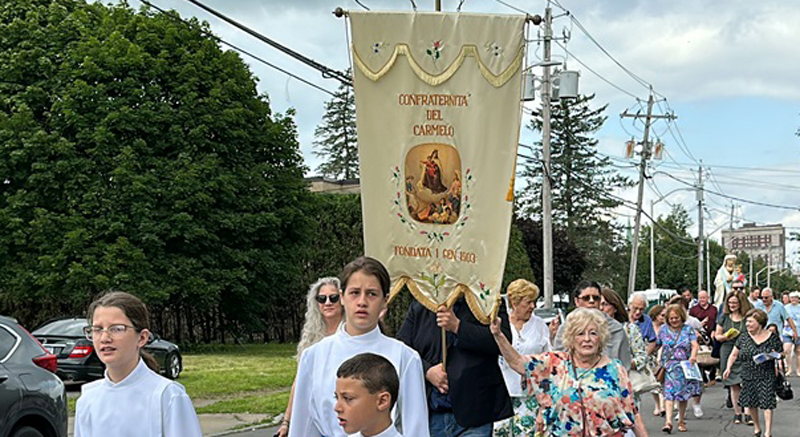In our parish today there are dedicated people who participate in one or more of the many, sometimes unnoticed, ministries to help carry on the day-to-day functioning of the church.
A group of nine women shares the chore of laundering of the altar linens and tend to the vestments used in daily and weekend Masses.

A roster of lectors shares the duties on a revolving schedule of reading the writings of the Old and New Testaments at Mass.
A number of eucharistic ministers distribute the body and blood of Christ at Mass.
Our Social Committee plans activities for parishioners, including the yearly Communion Breakfast following Sunday Mass.
A group is trying to return after a hiatus during COVID to perform Eucharistic service and visit the housebound and residents of nursing homes.
The Music Ministry prayerfully embellishes the celebration of Mass and funerals.
A decorating committee sees to it that the altar and sanctuary are appropriately garbed for the liturgical seasons.
Volunteers help spruce up the plantings and gardens on the parish campus.
During more than 125 years of its history, St. Mary of Mount Carmel has engaged its brothers and sisters, within our parish and into the greater community, in many acts of faith and kindness. Groups, or “societies,” were attached to their roots in far-off towns and villages from which parishioners emigrated, to their patron saints and honor cultural, familial and community bonds. Some were goal-oriented groups established for specific needs of the congregation. Some were designed to nurture and strengthen faith in our youth while others were designed to extend a hand at the end of someone’s life.
In the past, the calendar was filled with monthly devotions to this or that saint. These occasions included a solemn-high Mass and panegyric (a speech or proclamation of the virtues of the specific saint) and a procession with the faithful with musical accompaniment. These celebrations were usually held on the Sunday closest to the feast day of the targeted saint. Often, dinners and sometimes street festivals were included in the celebration.
Other societies were dedicated to specific or special causes. But like the population of the parish, activity has ebbed and flowed over the century and a quarter. At one time, more than 600 young men and women were confirmed at a time, necessitating two shifts of blessings by the visiting bishop. By 1923, there were 1,500 people in the various societies in the parish.
Today, though perhaps diminished in numbers, the good work of a few of these groups persists.
- Mount Carmel Society: Originally the Madonna del Carmine, it has been existence since 1898, it helped clear debt incurred in establishing building a new church and rectory. By 1901 it had achieved that goal. In 1903 it was officially founded and still is in existence today. It is a coed society that sponsors charitable work, makes donations in funds and volunteerism for the less fortunate, and makes occasional gifts to the parish, such the outdoor shrine to Our Lady of Mount Carmel. It is this group that is the driver running our annual parish feast.
- St. Anne Society: Still extant, it was the first English speaking religious society for women. It became a sort of “mother’s guild.” It assists the poor and disadvantaged of the parish and community, while observing reverence to the mother of the Blessed Virgin.
- La Congrega di Santa Rosalia Vergine Palermitana: This society was founded independently from the parish in 1915 but has collaborated with Mount Carmel for more than 107 years. Composed of immigrants and descendants of those arriving from Palermo and its province in Sicily, it was dedicated to the devotion of their patron saint, Santa Rosalia, aka La Santuzza. It originally was an all-male group but has morphed over the century to include men and women, as well as devoted individuals descended from families outside of Palermo and Sicily. It has enjoyed a recent revival over the past two years after having lost its tax-free status and almost losing its beloved chapel.
Glorious past
The list below includes groups that are no longer active or have entirely ceased to exist.
- Altar Rosary Society: This society spread devotion to Mary through recitation of the rosary and works of charity.
- Altar Society: Founded in 1923 by the Rev. John Marchegiani, it gifted the church sanctuary with the white Carrara marble flooring, communion rail and pulpit in 1931.
- Busy Bodies: Founded during the pastorate of the Rev. Carmen Negro (1979-83), the objectives of this group were social and to stay connected with, and support, the ill and housebound in the parish.
- Holy Name Society: As per its national website, “The Confraternity of the Most Holy Names of God and Jesus (Holy Name Society) promotes reverence for the sacred names of God and Jesus Christ, obedience and loyalty to the Magisterium of the Catholic Church, and the personal sanctification and holiness of its members.
- Italian Benevolent Society: Founded in the early years of our parish, it lent support to new immigrants to the community.
- Junior Holy Name Society: This group was founded in 1923 by Marchegiani as a group for youth.
- Mount Carmel High School Association: Founded under the pastorate of the Rev. William Pizzoglio (1934-50) for parish students, it was a precursor to the CYO.
- League of the Sacred Heart: Founded by Father Pizzoglio (1934-50), was organized to develop the devotion and consecration of families to the Sacred Heart.
- Legion of Mary: A group dedicated to devotion of the Blessed Mother.
- Morning Glories: A women’s group that met regularly for Mass and breakfast.
- St. Agnes Sodality: Founded in 1923 by Father Marchegiani, it no longer exists.
From the ‘Old Country’
The following societies were associated with the roots of their members:
- Castagnese Society: Composed of immigrants and descendants of those arriving from Castagna, a small village in Carlopoli of the province of Catanzaro, region of Calabria, Italy. There were two societies under this umbrella: Società Uomini (men) di Scandale and the Società Scandale di Mutuo Succorso (mutual aid).
- Società Nicastrese: Composed of immigrants and descendants of those arriving from Nicastro, a small town in the province of Catanzaro in the Calabria region of southern Italy, it was under the umbrella of the Società Femminile di Sant’Antonio (St. Anthony of Padua) di Nicastro and Nicastrese Society.
- Società Calabria: Composed of immigrants and descendants of those from Calabria.
- Società Scandalese: Composed of immigrants and descendants of those arriving from Scandale, a town in the province of Crotone, in the Calabria region of southern Italy.
- Società Femminile di San Donato di Misssanello: This group of women had roots in the Italian region of Basilicata.
- Congrega di San Rocco: Also with roots in the region of Basilicata, it was one of the largest groups in the parish. It sponsored a three-day feast on Mohawk Street and then at Quinn’s Playground and was open to anyone regardless of their place of origin.
- Terz’Ordine di San Francesco: A deeply religious group, it was associated with the Franciscan Nuns that staffed our parish school.
Mutual aid societies
- Società Pugliese: Origins in the region of Puglia, sponsored annual student scholarships for many years.
- Minturnese Society: Origins Minturno, Latina.
- Sicignanese Society: Origins Sicignano, Salerno.
- Nicastrese Society: Origins Nicastro Catanzaro.
- Castagnese Society: Origins Castagna-Lomezia, Catanzaro.
- Avanti Savoia Society: Origins from the Sons of Italy (Savoia was the royal family of Italy 1860-1946).
- Società Progresso e Aiuto: A businessmen’s association in the early 20th century.
We would like to express our appreciation to Jim Delitto, Rosemarie Chiffy and Vicki Perritano for their help in recalling some of the history of these important components of our parish from the past and present.
